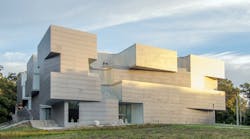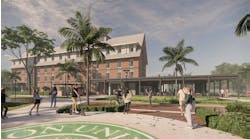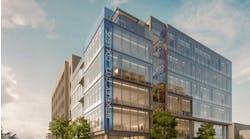The University of Iowa held a ribbon-cutting ceremony Friday to commemorate the opening of its new Visual Arts Building on the Iowa City campus. The facility replaces a building that was destroyed in a 2008 flood on campus.
BNIM Architects says the 126,000-square-foot facility is the new home for the School of Art & Art History
The building has studio space for ceramics, sculpture, metals, photography, printmaking, 3D design, intermedia, animation and graphic design, as well as graduate student studios, faculty and staff studios and offices, and gallery space.
Those functions were previously housed in the 1936 Art Building, one of several facilities on campus that sustained heavy damage in June 2008 when the Iowa River flooded. After the Federal Emergency Management Agency declared that the building could not be salvaged, university officials pursued plans for a replacement.
Construction of the $77 million building began in 2013 and was completed this summer, the university says. The facility was designed with a goal of received LEED Silver certification for environmentally friendly and energy-efficient features.
The design of the Visual Arts Building is a collaboration between Steven Holl Architects and BNIM.
“This project has been an exemplar of collaboration in realizing a functional and exhilarating facility for the School of Art & Art History,” says Rod Kruse, BNIM principal-in-charge. “This new facility is intended to lift the school to new levels of enrollment and success and will be a destination for students and professionals of art and architecture.”
The designers used computer modeling software to design the irregular shape of the structure and to coordinate the installation of the complex exposed mechanical pipes and ductwork.
Key design features include significant daylighting, natural ventilation at the atrium skylight, an innovative thermal active slab heating and cooling system, and highly efficient HVAC systems that use energy recovery wheels to recapture potentially lost thermal energy through the extensive exhaust system.
Natural light and natural ventilation are inserted into the deep floor plates by the inclusion of what the design team calls "multiple centers of light." Several vertical cutouts are designed to foster interaction among the facility’s four levels.
The atrium provides a central skylight and circulation space that results in a powerful core of the building. Sculptural open stairs are shaped to encourage meeting, interaction and discussion. Some stairs stop at landings with tables and chairs, others open onto lounge spaces with built in seating.


